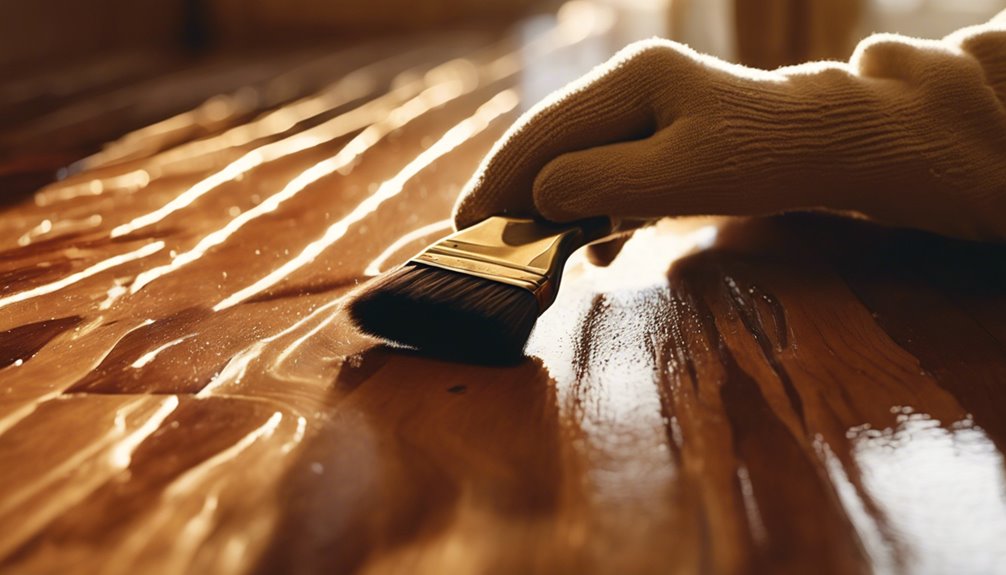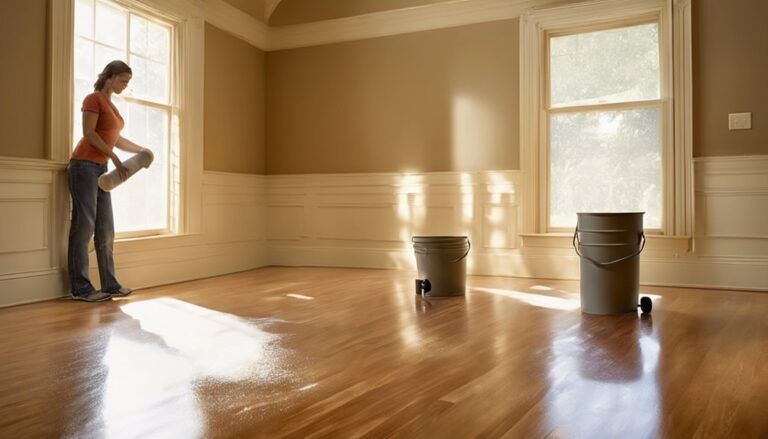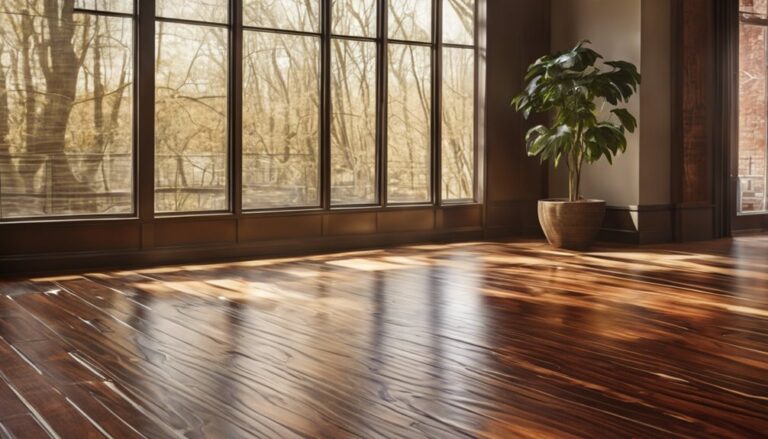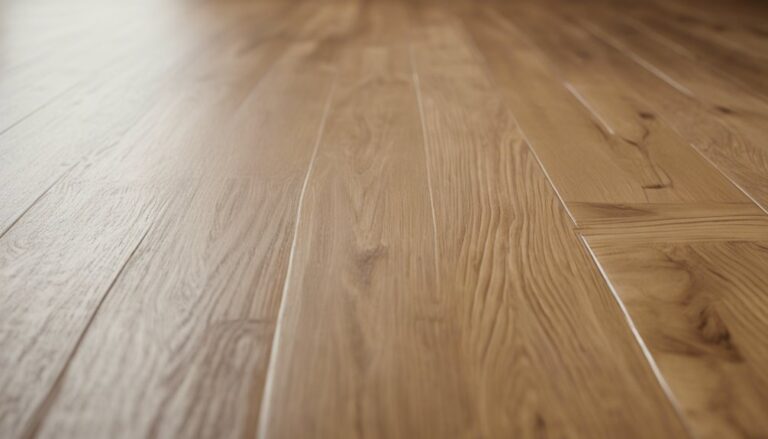To apply stain to hardwood floors, start by gathering the right materials, like oil-based or water-based stains, brushes, and protective gear. Clean the surface thoroughly and inspect for imperfections, sanding as needed. Choose your stain color wisely and test it in a hidden spot. When you're ready, apply the stain using long strokes that follow the grain, maintaining a wet edge for a uniform look. Allow the stain to penetrate per the manufacturer's directions, then wipe off excess. Finally, finish with a protective coat to extend durability. There's much more to learn about the finishing process.
Gather Your Materials
Before you begin staining your hardwood floors, it's essential to gather all necessary materials to guarantee a smooth and efficient process. Start by selecting your stain types—oil-based or water-based—each offering distinct finishes and drying times. Verify you have the appropriate application tools, like high-quality brushes, foam applicators, or staining pads, which will greatly impact the final look. Don't forget to include a clean cloth for any excess stain and a paint tray for easy access. Additionally, prepare for safety by acquiring gloves and a mask to protect yourself from fumes. Having these materials on hand means you can focus on achieving a beautiful finish, allowing your hardwood floors to shine without unnecessary interruptions.
Prepare the Hardwood Floors
To prepare your hardwood floors for staining, start by thoroughly cleaning the surface to remove any dust, dirt, or debris. Use effective cleaning methods, such as a vacuum or a microfiber mop, to guarantee a pristine base. Once cleaned, inspect the floors for any imperfections, including scratches or dents. Employ appropriate sanding techniques to smooth out these blemishes. Begin with a coarse-grit sandpaper to tackle deep scratches, then progress to finer grits for a polished finish. Remember to sand in the direction of the wood grain to avoid damaging the surface. After sanding, vacuum again to eliminate any remaining dust, making sure the area is ready for the stain application. This careful preparation is essential for achieving a flawless finish.
Choose the Right Stain
How do you determine which stain is best for your hardwood floors? First, consider color selection. Think about the overall aesthetic you want to achieve, whether it's a rich, dark hue or a light, airy finish. Each color can dramatically alter the room's ambiance. Next, familiarize yourself with stain types. Oil-based stains penetrate deeply, enhancing wood grain, while water-based stains dry quickly and emit fewer fumes. If you desire a natural look, a clear or semi-transparent stain might be ideal. For a bold statement, consider opaque stains. Always test your chosen stain on a small, inconspicuous area to ascertain it meets your expectations before committing to the entire floor. This step guarantees you'll achieve the desired look with freedom and confidence.
Apply the Stain
Once you've selected the right stain for your hardwood floors, it's time to apply it effectively. Start by preparing your tools: a high-quality brush or foam applicator works best for stain application. Begin in a corner and apply the stain using long, even strokes, following the grain of the wood. This method guarantees a smooth finish and reduces the risk of lap marks. For larger areas, consider using a staining pad to cover more ground quickly. Keep a wet edge as you work, blending each section seamlessly. Allow the stain to penetrate for the manufacturer's recommended time before wiping off the excess with a clean, lint-free cloth. Experiment with different staining techniques to achieve your desired look, enhancing your floors' natural beauty.
Finish and Protect
After the stain has dried, it is vital to apply a protective finish to safeguard your hardwood floors against wear and tear. You'll find various finish types available, such as polyurethane, varnish, and oil-based options. Each has its own characteristics; for instance, water-based polyurethane dries quickly and offers low odor, while oil-based finishes provide a richer color and durability.
Applying a protective coating is important for enhancing the floor's lifespan and maintaining its beauty. Start by ensuring the surface is clean and free from dust. Use a high-quality applicator or brush to evenly distribute the finish. Allow adequate drying time between coats, as per manufacturer recommendations. Ultimately, the right finish not only protects but also elevates the aesthetics of your hardwood floors.
Frequently Asked Questions
How Long Should I Wait Before Applying a Second Coat of Stain?
When considering stain application, it's essential to allow adequate drying time between coats. Generally, you should wait about 4 to 6 hours before applying a second coat of stain. However, this can vary based on humidity and temperature in your space. Always check the manufacturer's instructions for specific recommendations. Ensuring the first coat is thoroughly dry will enhance adhesion and achieve a more uniform finish for your project.
Can I Stain Over Previously Finished Hardwood Floors?
Yes, you can stain over previously finished hardwood floors, but it requires careful preparation. First, you'll need to perform stain removal on the existing finish, especially if it's a polyurethane or water-based finish, to guarantee proper adhesion. Different finish types may respond differently to staining, so thorough sanding is essential. After sanding, clean the surface well before applying your new stain to achieve an even, rich color that enhances the wood's natural beauty.
What Is the Best Temperature for Staining Hardwood Floors?
When it comes to staining hardwood floors, the ideal conditions are essential for achieving the best results. The temperature range you should aim for is between 50°F and 90°F. If it's too cold, the stain may not adhere properly, while excessive heat can cause it to dry too quickly, leading to uneven application. Always check the manufacturer's guidelines for specific recommendations, ensuring your project goes smoothly and delivers a professional finish.
How Do I Fix Mistakes Made During the Staining Process?
Mistakes during the staining process can feel like dark clouds on a sunny day, but they can be cleared away. For stain removal, use a cloth with mineral spirits to gently lift unwanted color. If you're dealing with uneven tones, color correction can be achieved by applying a lighter or darker stain over the affected areas. Remember to test on a hidden spot first to guarantee harmony in your flooring masterpiece.
Is It Safe to Stain Hardwood Floors While Living in the Home?
Staining hardwood floors while you're living in the home can be tricky. It's essential to prioritize stain safety; many stains emit volatile organic compounds (VOCs) that can affect indoor air quality. Guarantee proper ventilation and limit your living conditions in the stained areas during the drying process. Ideally, you should stay out of the space for at least 24 hours post-application to avoid exposure and allow the stain to cure effectively.




